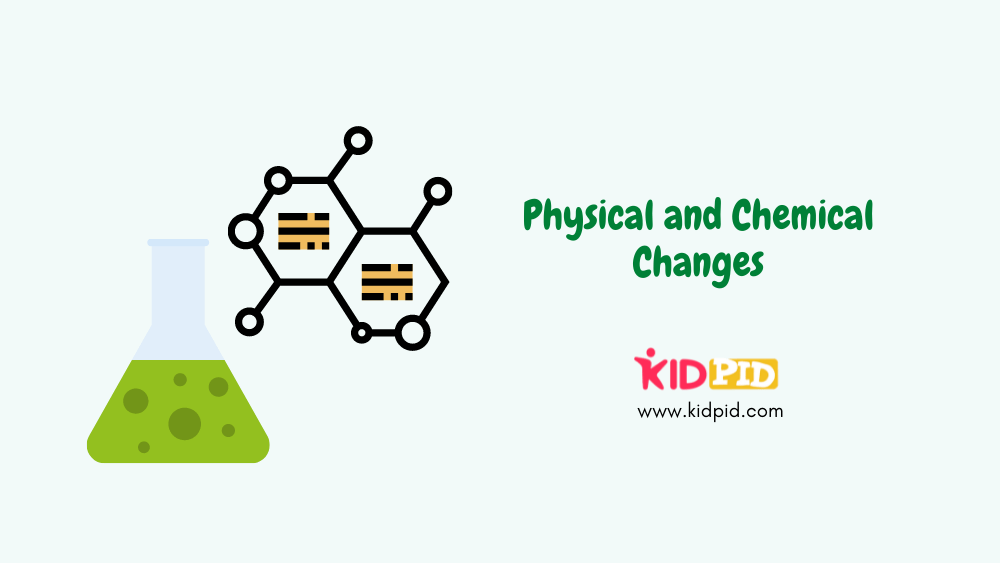In our everyday surroundings, we encounter or witness so many activities which involve change. These changes may include one or more than one object. The example of these types of changes are as follows:-
- Boiling of water is a change that changes the state of water.
- Melting ice into water is a change.
- Chopping a log of wood is also a kind of change.
- Mixing salt or sugar into the water makes the water sour or sweet as per the ingredient added – this is also a change.
- These are just some examples of change.
- There are many kinds of changes that take place and these changes are classified into two types. They are:-
- Physical changes
- Chemical changes
Contents
Physical Changes
Physical changes refer to the type of changes in which the outer appearance or the physical appearance of the object or matter changes.
- This type of change only affects the appearance of the matter.
- This change in physical properties may include the following:-
- Change in shape or size of the object.
- Change in odour
- Change in colour.
The change takes place only in terms of physical appearance without affecting the chemical properties of a material or substance.
Physical change is a completely reversible process or change.
Some common examples of Physical changes are:-
- Melting of ice
- Melting of chocolate
- Freezing of water into ice
Crystallisation
A common example of crystallisation is the formation of salt crystals on boiling sea water – the water completely evaporates leaving behind only crystals of salt.
-
- The process of converting or purifying crystals from a solution is called crystallisation.
- This process of separating out or formation of salt crystals is also known as salt crystallisation.
- This process of crystallisation is an example of physical changes.
Chemical Changes
Chemical changes refer to the type of changes in which the properties of the matter changes and one or more new substances are formed.
- Chemical changes are also referred to as chemical reactions.
- The new substances which are formed around us are the result of chemical changes and from that perspective, chemical changes are very important.
Some important examples of chemical changes are as follows:-
- Digestion of food
- Souring milk for preparing paneer, cottage cheese, etc.
- Burning of wood
- Cooking sugar to make caramel
- Usually, in a chemical change, the properties of the matter change, resulting in the formation of one or more than one new product.
The changes which happen during chemical changes are as follows:-
- The temperature of the new substance formed may change.
- There may be the slightest change in the odour or a completely new odour might come.
- Sometimes, even a precipitate can be formed.
- The state of the material may change. For example, the souring of milk results in the formation of semi-solid cheese curds from liquid milk.
Rusting of Iron
Rusting of iron may be defined as the formation of a reddish-brown substance (called rust) on any iron object over a period of time which weakens the material and eventually destroys it.
- Rusting of iron is one of the most common chemical changes that take place in our day to day lives.
- Rusting occurs due to the oxidation of iron in the presence of water and oxygen in the air.
- It is a very slow reaction that takes a long time. However, it is a type of chemical reaction that we can easily observe due to the visible rust formation on iron objects.
- There are several objects made of iron examples – bridges, almirahs, railings, etc.
- The process of rusting requires both water and air.
- This usually happens due to high moisture in the air.
Equationally, this process can be represented as
Iron(fe)+ oxygen(O2)+ water(H2O) = rust (iron oxide)(Fe2O3).
- Rusting of iron can be prevented by applying a coat of paint or varnish as it prevents any air or moisture from coming in contact with the iron surface.
- Steel alloys made from a combination of iron and carbon are less susceptible to rusting and last longer.
Galvanization
Another simpler way of protecting iron from rusting is by sedimenting layers of metals like zinc or say chromium. This process of applying a protective coat of zinc is known as galvanizing and is an effective method to prevent corrosion and rusting.
